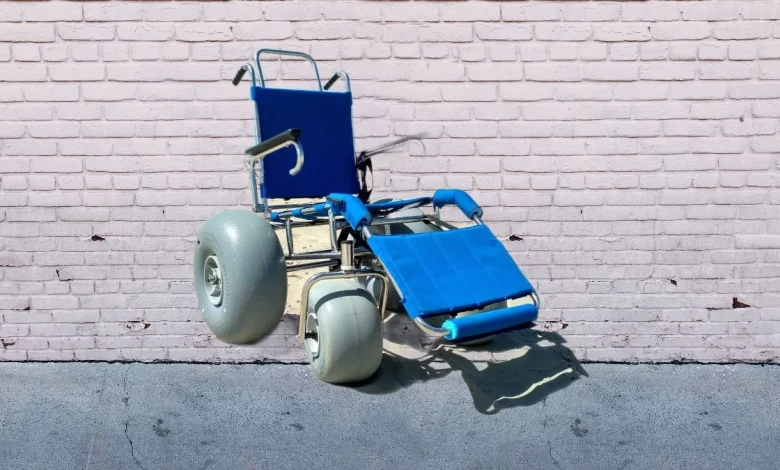Hit the Beach with Freedom: Your Guide to Beach Wheelchairs

Table of Contents
Hit the Beach with Freedom: Your Guide to Beach Wheelchairs
Beach Wheelchairs – Feel the Sand Between Your Toes (Again!)
Imagine the warm sun on your skin, the salty breeze in your hair, and the gentle sound of waves crashing on the shore. Now, picture yourself rolling freely across the sand, feeling the excellent grains beneath your wheels. That’s the magic of beach wheelchairs!
Beach wheelchairs are specially designed to allow people with mobility limitations to access and enjoy the beach. Unlike standard wheelchairs, which get stuck in the sand, beach wheelchairs have wide, inflatable tyres that glide effortlessly over loose terrain. They’re also made with corrosion-resistant materials to withstand saltwater and sunshine.
What Makes a Beach Wheelchair Different?
So, what sets a beach wheelchair apart from your everyday wheelchair? Here are some key features:
- Wide, inflatable tyres: These tyres provide better traction on sand and prevent the chair from sinking in.
- Corrosion-resistant materials: Beach wheelchairs are typically made from lightweight aluminium or stainless steel to resist rust and other damage from saltwater.
- Elevated seat: Some beach wheelchairs have a slightly higher seat to make navigating uneven terrain easier.
- Removable components: Detachable footrests and armrests can make transferring in and out of the chair on the beach more straightforward.
The Many Advantages of Beach Wheelchairs
Beach wheelchairs offer a world of benefits for people with mobility issues. Here are some of the most significant advantages:
- Independence: Beach wheelchairs empower users to explore the beach on their terms, without relying on others for assistance.
- Accessibility: They open up entire sections of the beach that would otherwise be inaccessible due to the sand.
- Safety: Beach wheelchairs provide a stable and secure way to navigate the beach, reducing the risk of falls or injuries.
- Social Interaction: Beach wheelchairs allow users to participate in all the fun beach activities with friends and family, fostering social interaction and inclusion.
- Mental and Physical Wellbeing: Spending time outdoors, soaking up the sun and enjoying the fresh air can significantly improve psychological and physical wellbeing for everyone.
Types of Beach Wheelchairs – Finding the Perfect Fit
Just like regular wheelchairs, beach wheelchairs come in different varieties, each catering to specific needs. Here’s a breakdown of the two main types:
- Manual Beach Wheelchairs: These are self-propelled chairs ideal for users with upper body strength and reasonable arm control. They’re typically lightweight and more accessible to manoeuvre on the sand.
- Electric Beach Wheelchairs: These motorized chairs offer a more effortless experience, perfect for users with limited upper body strength or those who get tired quickly. They can be more expensive than manual chairs and might require charging facilities nearby.
Pros and Cons of Beach Wheelchair Types
| Feature | Manual Beach Wheelchair | Electric Beach Wheelchair |
| Pros | Affordable, lightweight, maneuverable | Effortless operation, comfortable for long periods |
| Cons | Requires upper body strength | Heavier, bulkier, needs charging |
Additional Beach Wheelchair Considerations:
Beyond the main types, consider these factors when choosing a beach wheelchair:
- User weight capacity: Ensure the chair can accommodate the user’s weight comfortably.
- Terrain navigability: Some chairs are better suited for hard-packed sand, while others can handle loose or uneven terrain.
- Portability: If storage space is limited, consider a foldable or collapsible chair.
- Comfort features: Look for features like padded seats, adjustable backrests, and headrests for added comfort during long beach days.
Rent or Buy? Weighing Your Beach Wheelchair Options
Whether you rent or buy a beach wheelchair depends on your individual needs and budget. Here’s a breakdown of both options:
- Renting:
- Pros: Ideal for occasional use, saves on storage space, a good option for trying before you buy.
- Cons: Rental fees can add up over time, limited availability at some beaches.
- Buying:
- Pros: Convenient for frequent use, customizable options available, ownership provides peace of mind.
- Cons: Higher upfront cost, requires storage space, maintenance might be needed.
The best option for you depends on how often you plan to use the beach wheelchair. If you’re an occasional beachgoer best is to rent a beach wheelchair.
Enjoying the Beach with a Beach Wheelchair
Now that you’re equipped with your beach wheelchair, it’s time to hit the sand! Here are some tips to ensure a fantastic and accessible beach experience:
- Plan Your Beach Trip:
- Check beach accessibility: Many beaches offer designated accessible pathways and ramps leading down to the sand. Research online or contact the beach administration beforehand to ensure a smooth arrival.
- Time your visit: The tide plays a role! Opt for low tide when the sand is firmer and easier to navigate with your beach wheelchair.
- Pack smart: Bring essentials like sunscreen, a hat, sunglasses, a beach umbrella for shade, and plenty of water to stay hydrated. Consider packing a lightweight beach blanket or a special beach mat that creates a more stable surface for your wheelchair.
- Beach Etiquette for Beach Wheelchair Users:
- Be mindful of others: The beach is a shared space. Leave enough space for people to walk by comfortably.
- Communicate clearly: If you need assistance, politely ask nearby beachgoers or lifeguards for help.
- Respect the environment: Leave no trace behind! Dispose of your trash responsibly and avoid disturbing wildlife.
- Making Memories on the Sand (Inspirational Stories):
Imagine Sarah, a young girl who uses a wheelchair, finally being able to build sandcastles with her friends at the beach. Thanks to her beach wheelchair, she can roll right up to the water’s edge, feeling the calm waves lap at her toes. The joy on her face as she splashes in the shallows is priceless.
Beach wheelchairs are opening doors for people of all ages and abilities. John, an active senior who uses a beach wheelchair, can now continue enjoying his favourite pastime – beach volleyball! With the help of his friends, he sets up a modified court on the firmer sand and participates in the game with a big smile.
These stories showcase the transformative power of beach wheelchairs. They empower people to experience the beauty and joy of the beach, fostering inclusion and creating lasting memories.
Beach Wheelchair FAQs
- Are beach wheelchairs challenging to use?
While navigating sand requires some practice, most beach wheelchairs are designed for ease of use. Manual chairs require upper body strength, while electric chairs offer effortless operation.
- Can I swim in a beach wheelchair?
Most beach wheelchairs are not designed for swimming. However, some specialized models might offer flotation capabilities. Before entering the water, it’s essential to check the manufacturer’s specifications.
- Where can I rent a beach wheelchair?
Many Wheelchair Accessible Beaches offer beach wheelchair rentals, often through lifeguard stations or park services. Check the beach website or contact them beforehand for availability and reservation details.
- What resources can help me find a beach wheelchair?
Organizations like The Christopher & Dana Reeve Foundation and The PVA (Paralyzed Veterans of America) offer resources and information on beach wheelchairs, including rental programs and accessibility guides.
Conclusion: Embrace the Beach with Confidence
Beach wheelchairs are a game-changer, opening up the wonders of the beach to everyone. With the correct information and a touch of planning, you can experience the freedom and joy of the beach, regardless of your mobility limitations. So, pack your beach bag, grab your beach wheelchair, and get ready to feel the sand between your toes!



